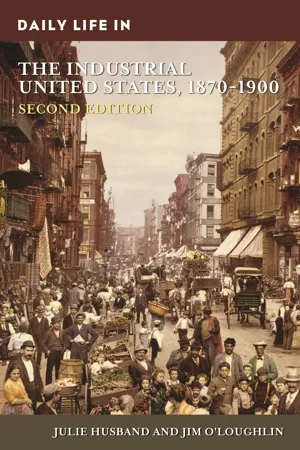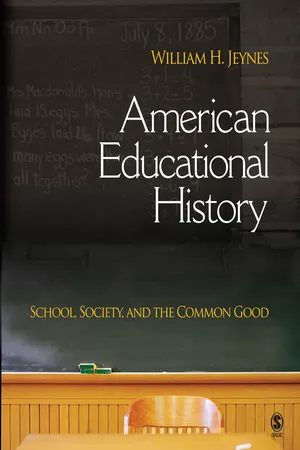History
Political Effects of The Civil War
The Civil War had significant political effects on the United States, including the abolition of slavery with the passage of the 13th Amendment, the expansion of federal power over the states, and the redefinition of the relationship between the federal government and individual states. These changes reshaped the political landscape and set the stage for the Reconstruction era.
Written by Perlego with AI-assistance
Related key terms
3 Key excerpts on "Political Effects of The Civil War"
- eBook - ePub
The World of Antebellum America
A Daily Life Encyclopedia [2 volumes]
- Alexandra Kindell, Alexandra Kindell(Authors)
- 2018(Publication Date)
- Greenwood(Publisher)
POLITICS AND WARFAREINTRODUCTIONThe subject of antebellum politics is vast and historians have written thousands of books and articles to give breadth and depth to the topic, but often the experience of everyday Americans and politics gets lost. We can read about topics such as biographies of individuals, specific events, and pieces of legislation or Supreme Court decisions in a lot of detail. On a more granular level, modern readers can know a lot about Andrew Jackson or read several books about the Dred Scott case or the settling and unsettling of Kansas. But to think about politics in terms of the daily lives of Americans is another matter. Most important to understanding this last point is keeping in mind, squarely, that politics mattered to many Americans. Politicians and other government agents took action on events that affected people’s lives—economically and morally. One of government’s most basic functions is to maintain stability, and prior to the Civil War, this was a difficult task for American politicians but essential to everyday people. Therefore, people paid attention to the big picture and the changes proposed during the era.The politics of economics were more than just regulating interest rates or assessing taxes. Congressmen did indeed battle over banks and tariffs (taxes on imports), yet fundamentally the issue was more complex: who should have the right to their labor and personal destinies, where should they be allowed to do that, and what role should the government have in helping or restricting people in the process? The politicians themselves had a hard time answering these questions, and often the answers they put forth caused as many troubles as they solved. For example, from the beginning, the Founders struggled with the idea of party politics, focusing on the federal system of government including checks and balances to provide compromise and consensus in times of disagreement. Yet as difficulties arose that they had not planned for, they formed ad hoc political parties—e.g., Federalists and Antifederalists—to make sense out of their differences for themselves and the people from whom they wanted votes. These parties, in one form or another, continued into the antebellum era. - Julie Husband, Jim O'Loughlin(Authors)
- 2019(Publication Date)
- Greenwood(Publisher)
This chapter considers the beliefs and practices that generated high participation rates across much of the country as well as the forces at play in suppressing black and Republican votes in the South. Because women were barred from voting in federal and most state and local elections, a specifically masculine culture developed, but women found means of indirectly influencing political culture and became some of the most ardent critics of the fraud and violence that marred it. Moreover, they became effective at pushing through public policy changes beneficial to women, children, and the working class.Through political participation, Americans addressed some of the new challenges facing an urbanizing and industrializing country. At the national level, the country was expanding on the transcontinental railroad, completed in 1869, with new routes that spawned rapid urban development. In social policy, it experimented with a pension system for Civil War veterans, their widows, and their children, and it restricted immigration for the first time. States and municipalities developed their own infrastructure to preserve the health and safety of urban dwellers—sewers, waterworks, trolley systems, electric streetlights, and tighter zoning to avoid fires. Finally, women activists and labor unions advanced policies aimed at protecting workers and offering greater security, though they met with significant resistance from large, powerful employers. By the end of the century, the federal government would weigh in on behalf of employers.Reconstruction in the SouthThe Civil War ended with the surrender of the eleven slave-holding states of the Confederacy in 1865, followed by a period of limited and somewhat ineffective rebuilding referred to as Presidential Reconstruction. A period of dramatic reorganization in the South, referred to as Congressional Reconstruction, began in 1868. Federal troops occupied the former Confederacy to administer these changes. For a brief period, until 1871, former Confederate soldiers were denied the vote in the South, resulting in a large Republican majority in Congress. Congress, dominated by “the party of Lincoln,” passed legislation establishing the Freedmen’s Bureau, which helped to resettle former slaves, sometimes offering them abandoned lands to cultivate and other times helping them to negotiate labor contracts with landowners. This help in negotiating contracts was crucial because former slaves owned no property, had to have work to survive, and were usually unable to read the contracts they signed, making them vulnerable to exploitation. The bureau also opened schools for African Americans. Expanded legal representation and education were costly compared with the limited government that had prevailed in the period prior to the Civil War. State governments across the South were funded by rising taxes on land. This on top of the debt many landowners had accrued during the war forced many to sell some or all of their land. In Edgefield, South Carolina, for example, landless white households increased from 25 percent in 1860 to 43 percent by 1870 (Kantrowitz 52).- eBook - ePub
American Educational History
School, Society, and the Common Good
- William H. Jeynes(Author)
- 2007(Publication Date)
- SAGE Publications, Inc(Publisher)
CHAPTER 7The Effects of Events During and Between the Civil War and World War I
D uring the period from 1861 to 1918, from the Civil War to World War I, the United States matured into a primary economic world power. By 1900, the United States maintained the highest standard of living of any nation in the world, a position it would hold until 1973 (U.S. Department of Labor, 2005). Educators believe that the ascending American education system of the 19th and early 20th centuries contributed measurably to the puissant economy that Americans would enjoy in the 20th century (Hungerford & Wassmer, 2004). Undoubtedly, the period from 1861 to 1918 was an important one in the history of American education. Urbanization, industrialization, and immigration would all have a prominent impact. In addition, schools assumed new social roles that produced some controversy. Educators also debated about what should be the appropriate nature of education for African Americans in the post–Civil War era. This chapter of American educational history also yielded a more well-defined American education system, which in most respects resembled that which the nation’s citizenry is familiar with today.IMPACT OF THE CIVIL WAR
Many historians claim that America did not become a full-fledged nation until the conclusion of the Civil War (Johnson, 1997). There are a number of reasons historians make this assertion.First, slavery had divided the nation prior to the Civil War. In a very real sense, as the slave trade grew, the nation became two nations under one roof (Johnson, 1997). On the basis of this reality, Abraham Lincoln (1858) made a famous speech in which he declared, paraphrasing Jesus in the New Testament, “A house divided against itself cannot stand.” Certainly with such a division tearing the country apart, the United States really could not function as one nation.
Learn about this page
Index pages curate the most relevant extracts from our library of academic textbooks. They’ve been created using an in-house natural language model (NLM), each adding context and meaning to key research topics.


